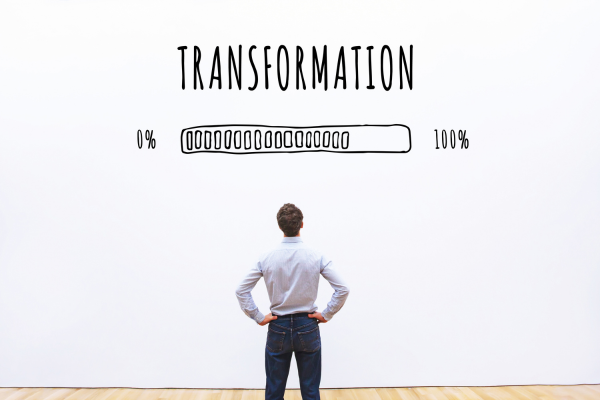"Especially in banking, it's still such a conservative industry, and people are very afraid of their employees going out there and building a personal brand and having a bad reflection on them." - Pattie Ehsaei
Personal branding is a subject that gives many people pause despite its incredible marketing potential. Whether it’s the fear of failure or an overwhelming desire for instant gratification, it’s easy to make excuses not to plant our flag in the ground.
The Duchess of Decorum herself, Pattie Ehsaei, believes financial leaders have the time and potential to provide value to others through personal branding content. They simply have to find it in themselves to take the first step.
Pattie, Senior Vice President at First Bank (FBNC), a thriving banking professional with a whopping one million followers across social media platforms, joined the Banking on Digital Growth Podcast with James Robert Lay to share how she's transforming her personal brand and making waves in the industry.
Top three insights from this article:
- Prioritize empathy: Incorporating empathy into banking practices can lead to stronger connections with customers and foster long-term relationships. Developing emotional intelligence and understanding the needs of diverse individuals can drive success in the industry.
- Embrace neurodiversity: Recognize the value of diverse thinking and innovative solutions that arise from embracing neurodiversity, including learning differences like ADD and ADHD. Creating an inclusive environment can fuel creativity and problem-solving, particularly in times of crisis.
- Utilize social media strategically: Don't underestimate the power of social media platforms like Instagram and TikTok in the banking industry. These channels can be used to educate and engage with customers, building a strong digital community. Focus on providing valuable content and helping people, rather than solely focusing on sales.
Empathy, Neurodiversity and Social Media Influence
The essence of Pattie's approach lies in James Robert's simple four-word mantra: help first, sell second.
And through this approach, she has built an enormous, engaging digital community on LinkedIn, Instagram, and TikTok.
"Really what inspired me is helping people," Pattie said. "I had all these great ideas in my head and I had no platform. I'm like, 'What am I going to do with it now?' Then I started to think through it...I'm going to make videos."
This realization sparked the birth of her media brand.
Her background of coming from an underserved immigrant background and dealing with learning disabilities like dyslexia and ADHD has shaped her perspective in banking.
Related Content: 200 Reasons to Bank on the Future and Build Your Personal Brand
"I really wanted to provide advice and mentorship for people that were like me, that don't have parents to teach them the ins and outs of work, the ins and outs of finance," she said.
Drawing from her personal experiences, Pattie has made an conscious effort to bring empathy into the banking industry.
"The most successful people in the world, the billionaires of the world, all them have a very high emotional IQ, which really is empathy," she observed. Empathy, as she sees it, is a muscle that can be taught, trained, and strengthened.
Related Content: Bridging IQ and EQ: Why Innovation Is Only As Good As Communication
The conversation also touched on the concept of "neurodiversity," a term that's gaining traction as a positive way to view learning differences like ADD and ADHD. Neurodiversity, Pattie and James Robert agreed, can lead to diverse thinking and innovative solutions, especially in times of crisis.
Dispelling misconceptions around the use of social media in the banking industry, Pattie firmly believes that platforms like Instagram and TikTok are not unprofessional.
"The misconception is that it's an unprofessional platform, Instagram and TikTok, and that's really what hinders people in their abilities," she said.
While she admits that TikTok doesn't directly bring in much business, it’s not the point. Pattie emphasizes the value of using these platforms to educate and help people navigate life better. In doing so, she has built an influential brand rooted in empathy and giving back, demonstrating the power of combining traditional banking with a modern media-first mindset.
As James Robert says, "People do business with people. That hasn't changed. It's just the way that we connect with people. That's been the big transformation over the past 2-5 years."
Making Positive Deposits with Helpful Content
Making positive deposits into the world has a direct impact on personal growth and success. There are long-term benefits of investing time and effort to pay it forward.
"There's this idea of, if I do X, then I will immediately receive Y. But if I make a deposit for good out into the world, that's going to come back to me in some way," James Robert explained, highlighting the concept of positive energy and its return.
Pattie agreed, stating, "When you put out positive energy into the world, you're attracting more positive energy because like attracts like."
Related Content: The Seismic Shift in Personal Branding
She further emphasized the significance of giving before receiving, citing the importance of referrals and the misconception of entitlement in today's society.
"You have to give first before you receive... You really have to focus on what your mission is rather than the results. The results will come."
Joe Polish's book, "What's in It for Them?" further support the idea that life gives to the giver and takes from the taker.
And this is notion is evident, as Pattie has created a substantial following on TikTok and LinkedIn, which has been built through her dedication to providing valuable content and helping others.
When discussing the potential influence of personal brands, Pattie acknowledged that the conservative nature of the banking industry often hinders individuals from building their personal brands.
However, she highlighted the importance of defining one's personal brand, understanding the parameters, and how supportive companies can contribute to personal growth.
Related Content: Building a Personal Brand Means Investing In Yourself
The conversation also touched on the investment of time required for personal brand development. Both James Robert and Pattie dismissed the notion of being too busy, encouraging financial brand leaders to find the time to invest in their personal growth.
They suggested reevaluating activities like excessive television consumption and embracing the idea of "the power of and" to create space for personal branding activities.
Furthermore, consider the need for a long-term perspective, as immediate gratification can hinder progress.
"We get so lost in not getting what we want right now, that we just give up... you have to pay the price for anything," she explained.
Let go of the instant gratification mindset and understand that achieving goals requires perseverance and sacrifice.
With a focus on giving first and embracing a future-oriented mindset, individuals can pave the way for their own growth and contribute positively to the world around them.
Overcoming Fear and Adding Value
There are four common fears that hold individuals back: fear of the unknown, fear of change, fear of failure, and fear of success.
James Robert encourages people to embrace education and learning as a way to overcome these fears and gain clarity.
Bridge the gap between thinking differently and taking action by recognizing that the person in the mirror is often their biggest critic.
Related Content: Sell Yourself: Having a Sales Plan for Your Personal Brand
"Haters" and critics are part of the game, both online and offline. Pattie has had her own experiences of facing criticism and emphasized the importance of not letting negativity hold you back.
Because as we know, F.E.A.R is often based on False Evidence Appearing Real.
For those looking to embark on a similar journey, Pattie advised focusing on adding value to your audience. She shared her experience of posting educational videos on LinkedIn about SBA financing and the positive responses she received.
Find a content delivery method that suits one's comfort level, whether it's videos, written articles, or other forms of media.
Building a personal brand takes time, effort, and perseverance. By investing in oneself, adding value to others, and pushing through fear, individuals can create a meaningful and successful personal brand in today's digital landscape.
Take Action Today:
- Develop empathy training programs: Implement training programs that focus on developing emotional intelligence and empathy among banking staff. This will enable them to better understand and connect with customers, leading to stronger relationships and customer loyalty.
- Foster a culture of inclusivity: Create an inclusive environment that celebrates neurodiversity and values diverse thinking. Encourage collaboration and provide support for individuals with learning differences. This can lead to innovative solutions and a more dynamic work environment.
- Leverage social media platforms strategically: Establish a presence on social media platforms such as Instagram, TikTok, and LinkedIn. Use these channels to share valuable content, educate customers, and build a community around your brand. Prioritize helping and providing value over direct selling, as this approach can cultivate trust and engagement with your audience.
For more about financial transformation, reach out to James Robert Lay at the Digital Growth Institute.
This article was originally published on May 12, 2023. All content © 2024 by Digital Growth Institute and may not be reproduced by any means without permission.





